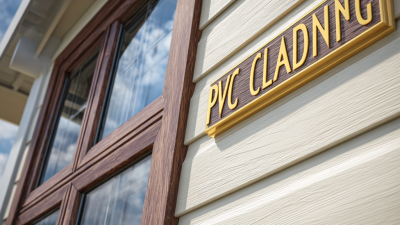Leave Your Message
-
Facebook
-
Whatsapp
-
Whatsapp


As sustainability becomes a key focus in construction and design, the demand for eco-friendly materials is on the rise. According to a report by Markets and Markets, the global market for eco-friendly building materials is projected to reach $600 billion by 2027, highlighting a significant shift towards environmentally responsible choices.

One such option gaining popularity is PVC Cladding Sheets, which offer a range of benefits including durability, low maintenance, and excellent insulation properties. Not only do these sheets contribute to energy efficiency, potentially reducing heating and cooling costs by up to 40%, but they also boast a long lifespan that minimizes waste in landfills. By choosing PVC Cladding Sheets, builders and homeowners can not only enhance the aesthetic appeal of their spaces but also play a crucial role in promoting a greener future.
PVC cladding sheets have increasingly gained attention for their potential to lower carbon footprints in the construction industry. According to a report by the Green Building Council, PVC's lifecycle analysis reveals that it can produce up to 70% lower carbon emissions compared to traditional materials like wood and metal. This reduction is largely attributed to PVC's lightweight nature, which decreases transportation emissions. Additionally, the energy required for manufacturing PVC cladding is significantly less than that of other conventional building materials, contributing to a decreased overall environmental impact.
Moreover, PVC cladding is designed for durability and longevity, meaning it does not need to be replaced frequently, thereby reducing waste over time. Industry data indicates that materials with a longer lifespan generate fewer emissions and waste, making PVC an environmentally responsible choice. Furthermore, the recyclability of PVC materials supports a circular economy, allowing for the reduction of raw material extraction and promoting sustainable practices in construction and renovation projects. As the construction industry seeks to embrace greener solutions, understanding the carbon footprint benefits of PVC cladding becomes crucial in making informed material choices.
PVC cladding sheets offer a range of benefits that make them an excellent choice for enhancing energy efficiency in buildings. One of the primary contributions is their insulation properties. By providing an additional layer of insulation, PVC cladding helps to regulate indoor temperatures, thereby reducing the need for heating and cooling. This not only leads to lower energy bills but also decreases the overall carbon footprint of the structure.
Moreover, PVC cladding is lightweight and easy to install, which minimizes energy consumption during the construction process. Its durability ensures that the cladding maintains its performance over time, requiring less maintenance and fewer repairs. By resisting moisture, UV light, and harsh weather conditions, PVC cladding helps to prolong the lifecycle of the building materials, thus promoting sustainability. As a result, incorporating PVC cladding into building designs is a strategic move for enhancing energy efficiency while adhering to eco-friendly principles.
PVC cladding sheets have emerged as a leading choice in sustainable construction, particularly due to their long-term durability and waste reduction capabilities. According to industry analysis, the global market for food service gloves, projected to reach USD 6.7 billion by 2025, highlights an increasing shift towards durable options like PVC gloves. These alternatives not only enhance safety standards during food preparation but also contribute to the reduction of single-use plastics.

The impressive longevity of PVC cladding sheets translates into fewer replacements and lower maintenance costs over time. Reports indicate that these materials can last up to 50 years with minimal wear, significantly decreasing the amount of waste generated from building materials. Moreover, as food service establishments increasingly adopt eco-friendly practices, the demand for high-quality, durable food service gloves, including PVC variants, continues to rise, aligning with the industry's commitment to sustainability. This approach reflects a broader trend towards responsibly sourced materials that meet both performance and environmental objectives.
In the realm of eco-friendly construction, PVC cladding sheets have emerged as a cost-effective alternative, combining sustainability with economic viability. According to a report by the Green Building Council, the use of PVC materials can result in a lifecycle cost reduction of 30% compared to traditional wood and metal cladding options. This is largely due to the durability of PVC, which not only extends the lifespan of the material but also reduces the frequency and cost associated with replacements and maintenance.
Furthermore, PVC cladding is highly energy-efficient. The U.S. Department of Energy indicates that buildings with proper cladding can achieve up to a 20% reduction in energy consumption for heating and cooling. This energy efficiency not only helps in reducing the carbon footprint but also translates into significant savings on energy bills over time. As the world increasingly moves towards sustainable building practices, the economic advantages of PVC cladding make it an attractive choice for environmentally conscious developers and homeowners alike.

When considering sustainable building practices, PVC cladding sheets emerge as a remarkable option due to their eco-friendly attributes. One of the top features of PVC cladding is its durability, which extends the lifespan of buildings while reducing the need for frequent replacements. This longevity means lower consumption of raw materials over time, contributing positively to resource conservation.
Additionally, PVC cladding sheets are often manufactured using recycled materials, minimizing waste and promoting a circular economy. Their energy-efficient properties help in maintaining optimal indoor temperatures, thereby reducing the reliance on heating and cooling systems. Furthermore, the non-toxic nature of modern PVC formulations ensures that they do not release harmful chemicals into the environment, making them a safe choice for both builders and occupants. These features collectively position PVC cladding sheets as a sustainable alternative in green building practices, reflecting a commitment to environmental stewardship while ensuring aesthetic appeal and functionality.
| Feature | Description | Environmental Impact | Lifespan (Years) |
|---|---|---|---|
| Recyclability | PVC cladding sheets can be recycled and repurposed, reducing waste. | Reduces landfill impact and promotes circular economy. | 30+ |
| Energy Efficiency | Provides excellent insulation, leading to reduced energy consumption for heating and cooling. | Decreases carbon footprint and energy bills. | 25 |
| Low Maintenance | Requires minimal upkeep, reducing the need for chemical cleaners and treatments. | Less environmental impact from maintenance products. | 30+ |
| Durability | Resistant to rot, corrosion, and pests, ensuring long-lasting installations. | Minimizes replacement waste and resource consumption. | 40+ |
| Aesthetic Versatility | Available in various designs and colors, enhancing building aesthetics without compromising sustainability. | Supports green architecture by improving building design. | 30+ |






